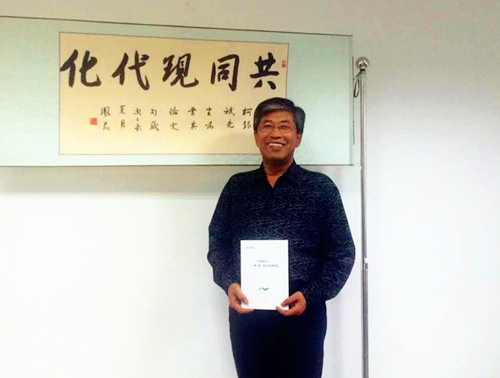Think tank reveals essence of 'Belt and Road'
- By Zhang Rui
 0 Comment(s)
0 Comment(s) Print
Print E-mail China.org.cn, September 29, 2015
E-mail China.org.cn, September 29, 2015
|
|
|
Ke Yinbin, secretary-general and senior fellow of the Charhar Institute, poses with his research report on the "Belt and Road" initiative at a seminar in Beijing on Sept. 28, 2015. [China.org.cn] |
A Chinese think tank released a study report in Beijing on Monday, saying it understands the substantive characteristics of the China-promoted "Belt and Road" initiative.
Ke Yinbin, secretary-general and senior fellow of the Charhar Institute, spearheaded research and wrote the report entitled "Common Modernization: the Essential Characteristics of the 'Belt and Road' initiative."
Ke said he has collected and scanned a vast amount of documents, top leader's speeches, government reports, news reports on the "Belt and Road" initiative and has found two key words: "Common" and "Modernization." For example, in a speech by President Xi Jinping at the Boao Forum for Asia in 2015, he mentioned "common" 29 times, "community" 14 times, "common development" six times and "common win" eight times. He also mentioned "cooperation" 35 times, which has a similar meaning that is also indicative of the word "common."
Xi also mentioned "development" 56 times in that speech. Ke thinks it should be identified as equivalent to "modernization."
"He impressed me at the Boao in March saying the 'Belt and Road' is a choir instead of a solo," Ke said. "I figured out the idea of 'common modernization' in April, since the countries along the Silk Road and Maritime Silk Road, which are mostly developing countries, need development, also understood as modernization for them."
Then he combed, measured and analyzed the two sets of scalar of what is the main body of modernization, the nation-state or the international system. He was also determined to define the goal of modernization, be it either economic growth or full development. Finally, he came to the conclusion that "common modernization" is modernization based on the international system which is aimed at full development.
Ke also noted five aspects of the "Belt and Road" initiative that should be achieved and studied. The goal would be to achieve common interests, he said, the body would be the community consisting of multiple countries while the principles would include "jointly discussing, building, and sharing" and "cooperation and win-win." He said the content will be communication and exchange while the approach will have international cooperation at its core.
The "Belt and Road" initiative, which refers to the Silk Road Economic Belt and the 21st Century Maritime Silk Road initiatives, were put forward by Chinese President Xi Jinping during his overseas visits in 2013, when he announced that China will push forward with the initiatives and strengthen cooperation with countries throughout Asia, the Middle East and on to Europe.
The veteran researcher said the "common modernization" theory is the connector which links the "Belt and Road" initiative and other countries' similar national development strategies.
He also pointed out that non-governmental organizations are an important part of resolving global issues. Chinese government and enterprises should learn to deal with and communicate with NGOs when they reach out to the world, otherwise they will encounter resistance and difficulty in the course of going out.




Go to Forum >>0 Comment(s)